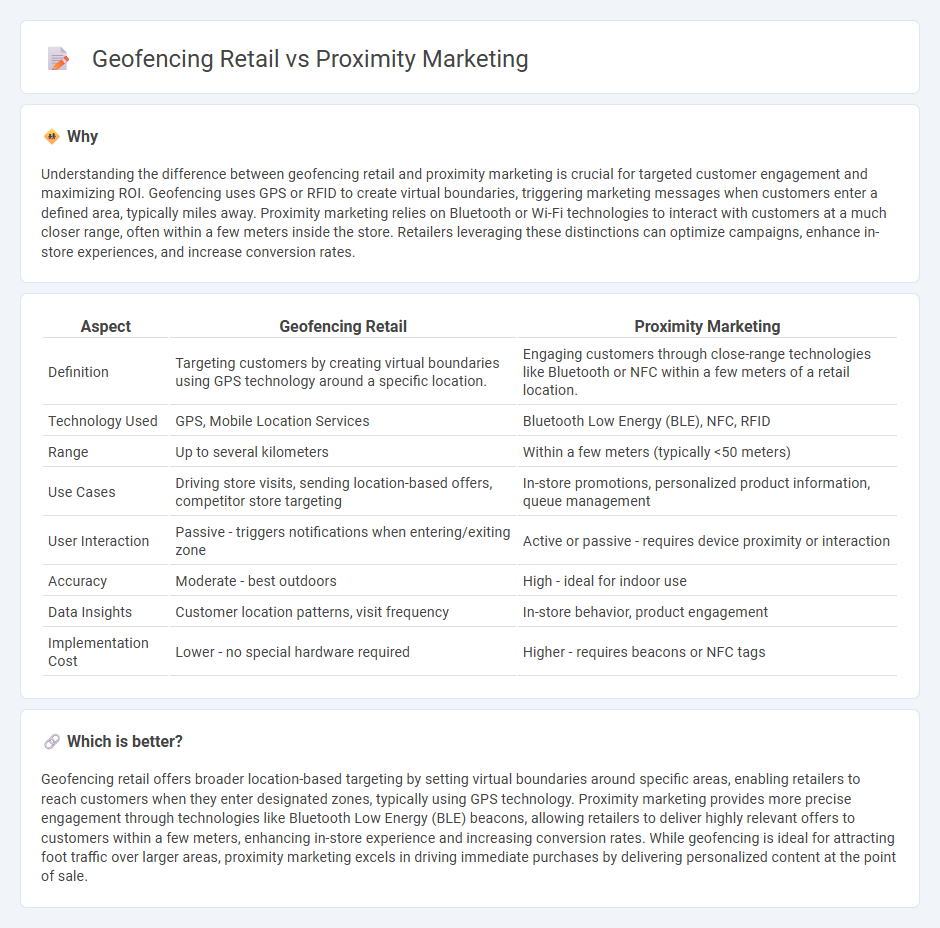
Geofencing retail leverages GPS or RFID technology to create virtual boundaries, triggering targeted marketing messages when customers enter a predefined area, boosting localized engagement and foot traffic. Proximity marketing uses Bluetooth Low Energy (BLE) beacons to send hyper-relevant offers and notifications directly to shoppers' mobile devices within a closer physical range, enhancing personalized shopping experiences and increasing conversion rates. Explore how combining geofencing and proximity marketing strategies can revolutionize customer interaction in retail environments.
Why it is important
Understanding the difference between geofencing retail and proximity marketing is crucial for targeted customer engagement and maximizing ROI. Geofencing uses GPS or RFID to create virtual boundaries, triggering marketing messages when customers enter a defined area, typically miles away. Proximity marketing relies on Bluetooth or Wi-Fi technologies to interact with customers at a much closer range, often within a few meters inside the store. Retailers leveraging these distinctions can optimize campaigns, enhance in-store experiences, and increase conversion rates.
Comparison Table
| Aspect | Geofencing Retail | Proximity Marketing |
|---|---|---|
| Definition | Targeting customers by creating virtual boundaries using GPS technology around a specific location. | Engaging customers through close-range technologies like Bluetooth or NFC within a few meters of a retail location. |
| Technology Used | GPS, Mobile Location Services | Bluetooth Low Energy (BLE), NFC, RFID |
| Range | Up to several kilometers | Within a few meters (typically <50 meters) |
| Use Cases | Driving store visits, sending location-based offers, competitor store targeting | In-store promotions, personalized product information, queue management |
| User Interaction | Passive - triggers notifications when entering/exiting zone | Active or passive - requires device proximity or interaction |
| Accuracy | Moderate - best outdoors | High - ideal for indoor use |
| Data Insights | Customer location patterns, visit frequency | In-store behavior, product engagement |
| Implementation Cost | Lower - no special hardware required | Higher - requires beacons or NFC tags |
Which is better?
Geofencing retail offers broader location-based targeting by setting virtual boundaries around specific areas, enabling retailers to reach customers when they enter designated zones, typically using GPS technology. Proximity marketing provides more precise engagement through technologies like Bluetooth Low Energy (BLE) beacons, allowing retailers to deliver highly relevant offers to customers within a few meters, enhancing in-store experience and increasing conversion rates. While geofencing is ideal for attracting foot traffic over larger areas, proximity marketing excels in driving immediate purchases by delivering personalized content at the point of sale.
Connection
Geofencing retail leverages location-based technology to create virtual boundaries around physical stores, triggering targeted marketing messages when customers enter these zones. Proximity marketing enhances this approach by delivering personalized promotions and offers via Bluetooth or Wi-Fi to customers' mobile devices within close range. Together, they enable precise customer engagement and drive foot traffic, increasing in-store sales and enhancing the overall shopping experience.
Key Terms
Location-based targeting
Proximity marketing leverages Bluetooth Low Energy (BLE) beacons to engage customers within a close range, offering personalized promotions based on precise in-store locations. Geofencing retail uses GPS technology to create virtual perimeters around specific geographic areas, triggering location-based ads when customers enter or exit these zones. Explore how integrating both methods can enhance targeted retail marketing strategies effectively.
Customer engagement
Proximity marketing uses Bluetooth, NFC, or Wi-Fi to send personalized offers to customers within a close range, enhancing in-store engagement and driving immediate action. Geofencing retail employs GPS technology to create virtual boundaries around specific locations, triggering notifications when customers enter or exit these zones, effectively increasing foot traffic and boosting local promotions. Explore how combining these strategies can optimize customer engagement and retail performance.
Real-time notifications
Proximity marketing uses Bluetooth Low Energy (BLE) beacons to send real-time notifications when customers are near specific retail locations, enhancing personalized engagement. Geofencing retail relies on GPS technology to create virtual boundaries, triggering alerts as customers enter or exit designated zones for dynamic in-store or nearby promotions. Explore how leveraging these technologies can boost customer interaction and sales in retail environments.
Source and External Links
Proximity Marketing: Engaging Customers at the Right Place and Time - Proximity marketing uses location technologies like Bluetooth, NFC, and Wi-Fi to send targeted messages to customers' mobile devices when they are near a business, enhancing relevance and engagement.
Proximity Marketing - Definition, Benefits & Beacons | Optimove - This technique delivers personalized marketing content to customers based on their real-time location, utilizing methods such as Wi-Fi, GPS geofencing, NFC, and Bluetooth beacons to increase conversion chances.
Proximity Marketing [Complete Guide to Success] - GroundTruth - Proximity marketing leverages mobile location technologies to deliver hyper-local, personalized promotions to consumers within specific areas, enabling precise targeting and detailed campaign tracking.
 dowidth.com
dowidth.com